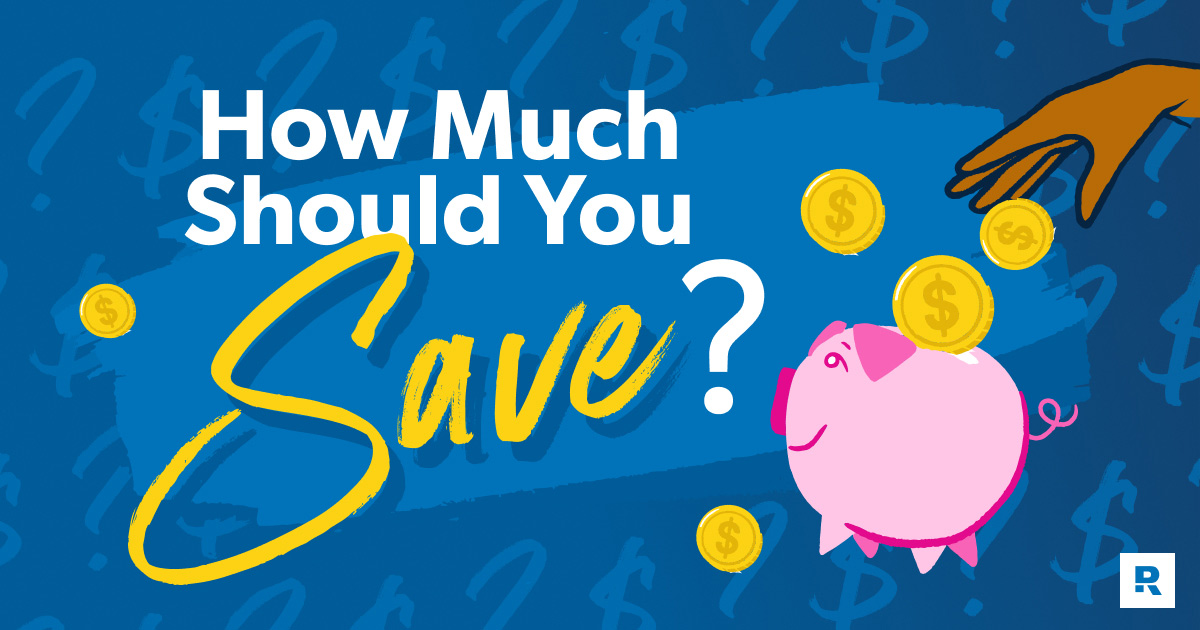
If you’re wondering how much you should have in savings, that exact amount really revolves around your current money situation. So, let’s start with a broad answer and then walk through how to find your specific number!
How Much Should I Have in Savings?
The quick answer is this: It depends!
To give you an idea of what’s common, here’s the median amount Americans have in savings by age:
|
Age |
Median Amount in Savings1 |
|
Less than 35 |
$5,400 |
|
35–44 |
$7,500 |
|
45–54 |
$8,700 |
|
55–64 |
$8,000 |
|
65–74 |
$13,400 |
|
75+ |
$10,000 |
Now, does that mean you should take the amount that matches your age range and make it your target goal? Nope. How much you should have in savings shouldn’t be based on a government stat. It should be based on where you are with your money.
Eventually, your goal is to have 3–6 months of expenses in a fully funded emergency fund and at least 15% of your gross pay going into retirement savings. (These are part of the 7 Baby Steps, aka the proven method to saving money, paying off debt, and building lasting wealth.)
Let’s look at some examples.
- Say your family’s monthly expenses are around $5,000. That means you’re sitting on an emergency fund of $15,000–30,000.
- And if your family’s gross annual income is $100,000, that means $1,250 a month is going into retirement savings ($100,000 times 15% divided by 12 months in a year).
Plus, if you’re saving up for a big purchase or expense (like the down payment on a house or your kid’s band trip to NYC) you need to set a savings goal and actively put away money each month to hit that goal.
But remember, we said eventually.
That might not be where you’re at right now. Which is why it’s so dang hard to quickly answer “how much should I have in savings?” for every single person!
Knowing those are your bigger savings goals (saving for emergencies, retirement and big purchases), let’s break down how you’ll know when to work on each one—aka how much you should have in savings right now vs. down the road.
To get your exact answer, ask yourself these questions:
1. Do I have $1,000 in savings?
If you don’t have at least $1,000 right now, this starter emergency fund should be a top saving priority for you. (We call this Baby Step 1.) Cut spending, take on side hustles, try a no-spend challenge. Do what it takes to get $1,000 in savings. Pronto.
2. Do I have debt?
If you have debt, the answer to “how much should I have in savings?” is $1,000 for emergencies while you double down on paying off debt (aka Baby Step 2). We’ll talk more about the why behind this in a bit.
Now, if you’re wondering if $1,000 is enough to cover every single emergency in life, well, it isn’t. But remember, this is your starter emergency fund. It’s a buffer between you and life.
Once you’re debt-free and have all that income going back into your budget instead of off to cover payments, you can beef up this fund. Which brings us to our next question:
3. If I’m debt-free, do I have 3–6 months of expenses in savings?
Once your debt is gone, you need a fully funded emergency fund, which will cover you in case of big emergencies like job loss. (This is Baby Step 3, BTW.)
But how do you know if your savings should have the three or six months of expenses in there? Here’s a quick rundown.
Save three months of expenses if:
- You’re single with no dependents and have a stable income
- You’re married and each of you has a stable income
Save six months of expenses if:
- You’re married with a single income
- You’re a single parent
- Your job is seasonal
- Someone in your home is chronically ill
- You or your spouse is self-employed or has a highly irregular income
4. Do I have any big purchases or expenses coming up?
If you’ve got a big expense coming up, a sinking fund is your new BFF. With a sinking fund, you save up an amount of money by setting aside a bit each month.
Calculate the growth of your savings account with this free tool.
How much you should have in savings inside a sinking fund depends on two things: time and total. How long do you have to save and how much total money do you need?
For example, if you’ve got five months to save for your $1,000 Alaskan railroad trip, you need to set aside $200 every month. (Just don’t bunk with a mysterious rich heiress. That’s how too many Agatha Christie novels begin.)
5. If I have 3–6 months of expenses saved, am I putting 15% away for retirement savings?
Once you’ve got your savings ready for bigger emergencies, you can focus on saving for retirement! Start investing 15% of your gross household income—which is Baby Step 4.
If your employer offers a 401(k), invest up to the match there. Then open a Roth IRA and contribute as much as they’ll let you here! (Yes, there’s a cap on that.) If you hit the max and still haven’t reached 15% of your income, go back to your 401(k) and contribute the rest there!
Okay, after you answer those questions, you’ll know how much you should have in savings right now—and even what your next savings goal should be! We love a clear path. Brilliant.
Save more. Spend better. Budget confidently.
Get EveryDollar: the free app that makes creating—and keeping—a budget simple. (Yes, please.)
How Much Does the Average American Have in Savings?
We gave you some numbers by age already, but those don’t show the full picture when it comes to American savings accounts. The Federal Reserve reports that 37% of Americans wouldn’t be able to cover a $400 emergency.2
And our State of Personal Finance shares that 49% of Americans have at least $1,000 in savings, but 33% have no savings. At all.
Between the lack of savings and the increase in costs, more Americans are turning to credit cards. But their average interest rate is at an all-time high of 22.75%.3 Gag. No.
Making savings a priority helps you avoid paying those high interest rates—because you’ll have the cash to cover your needs. And thank goodness, cash is interest-free!
How Much of My Paycheck Should I Save?
If you’ve heard of the 50/30/20 rule for budgeting, it says you should stash 20% of your paycheck into savings every month always. But here’s the deal: Sticking to that 20% isn’t always doable—or advisable.
Remember, if you’re in debt, getting those payments out of your life is your number one financial goal. In those first Baby Steps, it's not about sticking to a set budget percentage. It’s all about building momentum and giving each of your goals everything you’ve got—one at a time.
For those of us who do love a percentage, remember, it’s coming in Baby Step 4— that’s when you’ll have 15% of your income going to retirement savings. And if you’ve got another savings goal, put as much as you can into sinking funds to reach those goals.
Where Should I Keep My Savings?
Now that you know how much you should have in savings, you might wonder where to keep all that cash. The answer is not under your mattress, in your sock drawer, or buried in a tin can in your backyard. The answer depends on what that savings is for—an emergency fund or a sinking fund.
Where to Keep an Emergency Fund
You’ll want to be able to access the money in your emergency fund quickly and easily—but not so easily that you can impulse buy a train ticket for that Alaskan railroad trip. This is your emergency fund, not your fun fund.
Check out money market accounts. Most of them come with a debit card and checks so you can get to your money when you need it. Look into high-yield savings accounts because they offer higher interest rates. Having the security of emergency savings while making a little extra money? Yes, please. (Just remember this is your emergency fund—not an investment. It’s not there to help you get rich. It's there to provide security when you need it most.)
Where to Keep Sinking Funds
Store your sinking fund money in a regular savings account. As long as there’s no penalty for taking the money out (or a minimum balance you have to keep), you’re good to go.
Another option is to keep that money in your checking account and track it in your budget with EveryDollar. There’s a special sinking fund feature in EveryDollar to help you keep up with it all. Just make sure you don’t go on a major spending spree when you see that padded bank account.
How to Grow Your Savings
If you want to put more into savings, you’ll need to put in some work to save more money! Okay, that might sound obvious, but it’s worth saying. And here are a few ways you can do it:
Increase Your Income
Your income is your greatest wealth-building tool. So, if you can increase that income, you’ll have more you can throw at your savings goals. Get a side hustle, sell stuff, pick up freelance work, or ask for a raise (maybe not on day three of training at your new job for that last one).
Decrease Your Expenses
On the opposite side of this money-saving coin, if you’re spending less, you’ll also have more money freed up to save. Cut down expenses by meal planning, buying generic products, ditching the second (and third) television streaming service you’re paying for . . . you get the idea.
Ditch Your Debt
Remember what we just said about your income being your greatest wealth-building tool? Well, if you’re in debt, that tool isn’t working at its max potential.
Check out this math: The average monthly credit card debt payment is $116.10, and the average used car payment is $532.4,5 That’s around $640 a month that could go to savings—or to literally anything else you want—but it’s stuck going to payments. And that’s not even including if you’ve got student loans, personal loans or other debt.
We aren’t saying this to intimidate you but to empower you! Ditch the debt and reclaim your income. All. Of. It.
Use a Budget
A budget is just a plan for your money—everything coming in and going out. When you budget, you get organized and you get wise. You’ll see where your money is going every month. And you’ll start telling it where to go.
Think about it: Right now, you want to tell more money to go into savings—so you need to budget! And we’ve already told you about our free budgeting tool, EveryDollar. You can set up savings goals (big and small), create sinking funds . . . all within your monthly budget. It’s free (worth saying again). It’s simple. And it’s just what you need to make the most of your money and get your savings stacked.
Let’s do this.



